Page 114 of 250
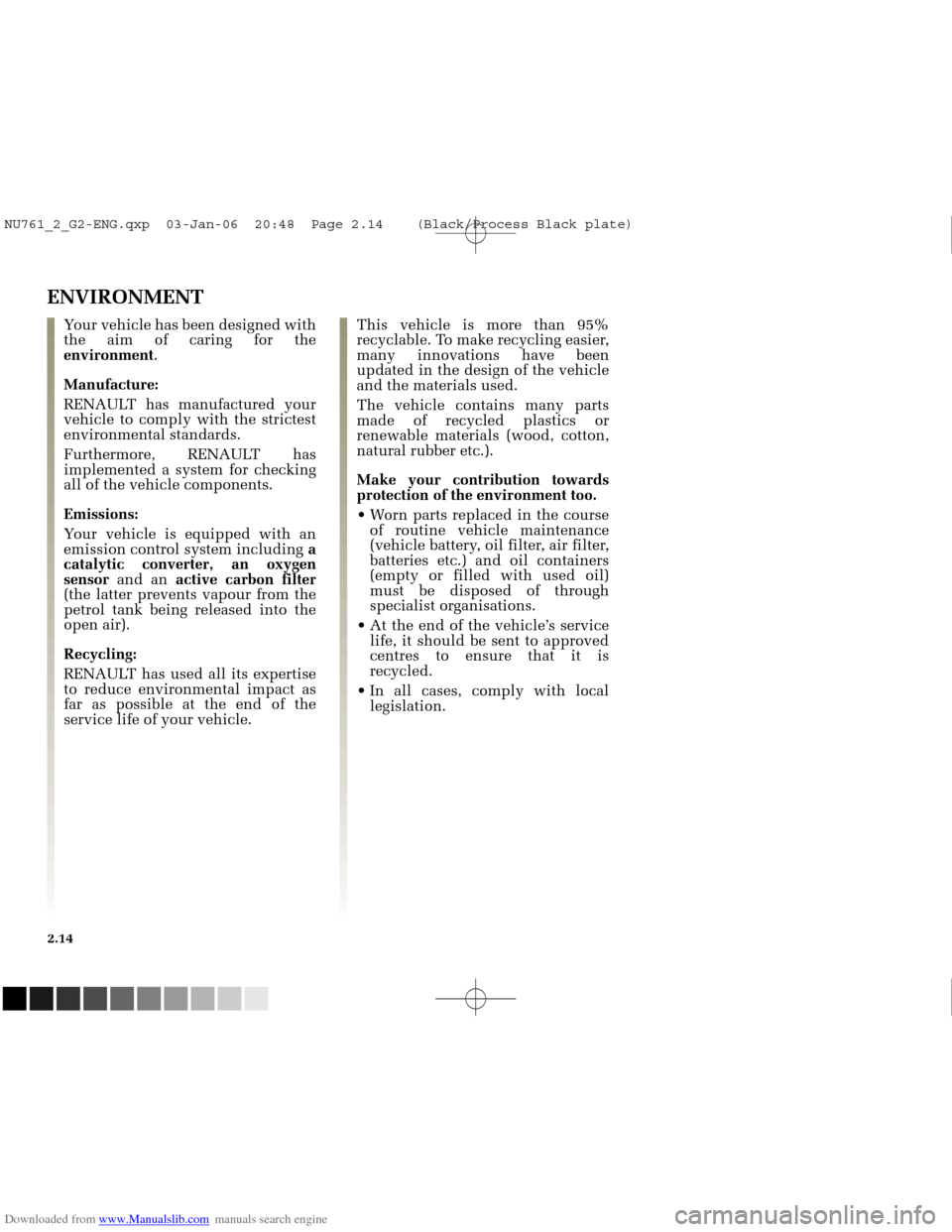
Downloaded from www.Manualslib.com manuals search engine
NU761_2_G2-FRA.qxd 4/11/05 10:48 Page 2.14
2.14
ENVIRONMENT
Your vehicle has been designed with
the aim of caring for the
environment.
Manufacture:
RENAULT has manufactured your
vehicle to comply with the strictest
environmental standards.
Furthermore, RENAULT has
implemented a system for checking
all of the vehicle components.
Emissions:
Your vehicle is equipped with an
emission control system including a
catalytic converter, an oxygen
sensor and an active carbon filter
(the latter prevents vapour from the
petrol tank being released into the
open air).
Recycling:
RENAULT has used all its expertise
to reduce environmental impact as
far as possible at the end of the
service life of your vehicle. This vehicle is more than 95%
recyclable. To make recycling easier,
many innovations have been
updated in the design of the vehicle
and the materials used.
The vehicle contains many parts
made of recycled plastics or
renewable materials (wood, cotton,
natural rubber etc.).
Make your contribution towards
protection of the environment too.
of routine vehicle maintenance
(vehicle battery, oil filter, air filter,
batteries etc.) and oil containers
(empty or filled with used oil)
must be disposed of through
specialist organisations.
life, it should be sent to approved
centres to ensure that it is
recycled.
legislation.
NU761_2_G2-ENG.qxp 03-Jan-06 20:48 Page 2.14 (Black/Process Black\
plate)
Page 154 of 250
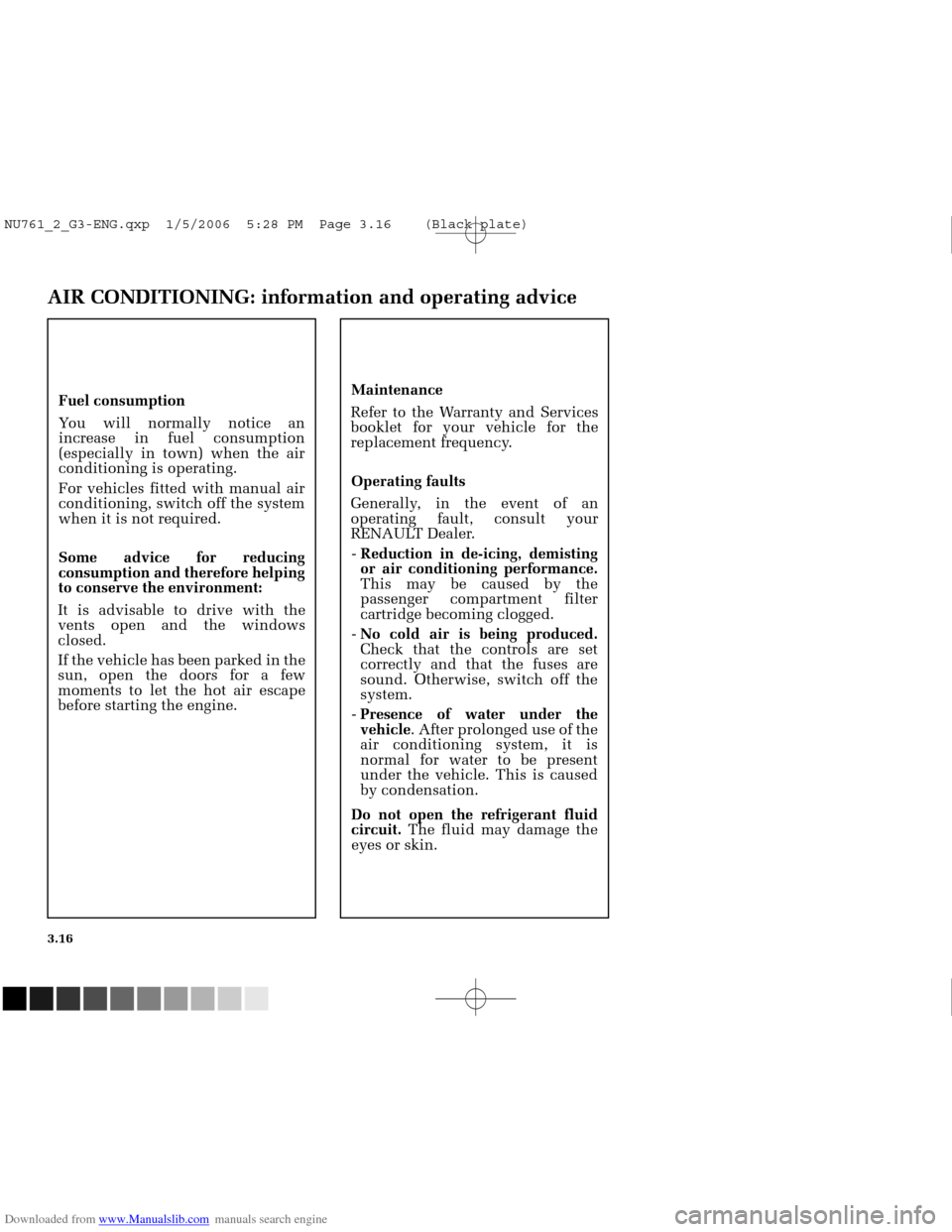
Downloaded from www.Manualslib.com manuals search engine
NU761_2_G3-FRA.qxd 4/11/05 10:51 Page 3.16
3.16
AIR CONDITIONING: information and operating advice
Fuel consumption
You will normally notice an
increase in fuel consumption
(especially in town) when the air
conditioning is operating.
For vehicles fitted with manual air
conditioning, switch off the system
when it is not required.
Some advice for reducing
consumption and therefore helping
to conserve the environment:
It is advisable to drive with the
vents open and the windows
closed.
If the vehicle has been parked in the
sun, open the doors for a few
moments to let the hot air escape
before starting the engine.Maintenance
Refer to the Warranty and Services
booklet for your vehicle for the
replacement frequency.
Operating faults
Generally, in the event of an
operating fault, consult your
RENAULT Dealer. - Reduction in de-icing, demisting
or air conditioning performance.
This may be caused by the
passenger compartment filter
cartridge becoming clogged.
- No cold air is being produced.
Check that the controls are set
correctly and that the fuses are
sound. Otherwise, switch off the
system.
- Presence of water under the
vehicle . After prolonged use of the
air conditioning system, it is
normal for water to be present
under the vehicle. This is caused
by condensation.
Do not open the refrigerant fluid
circuit. The fluid may damage the
eyes or skin.
NU761_2_G3-ENG.qxp 1/5/2006 5:28 PM Page 3.16 (Black plate)
Page 181 of 250
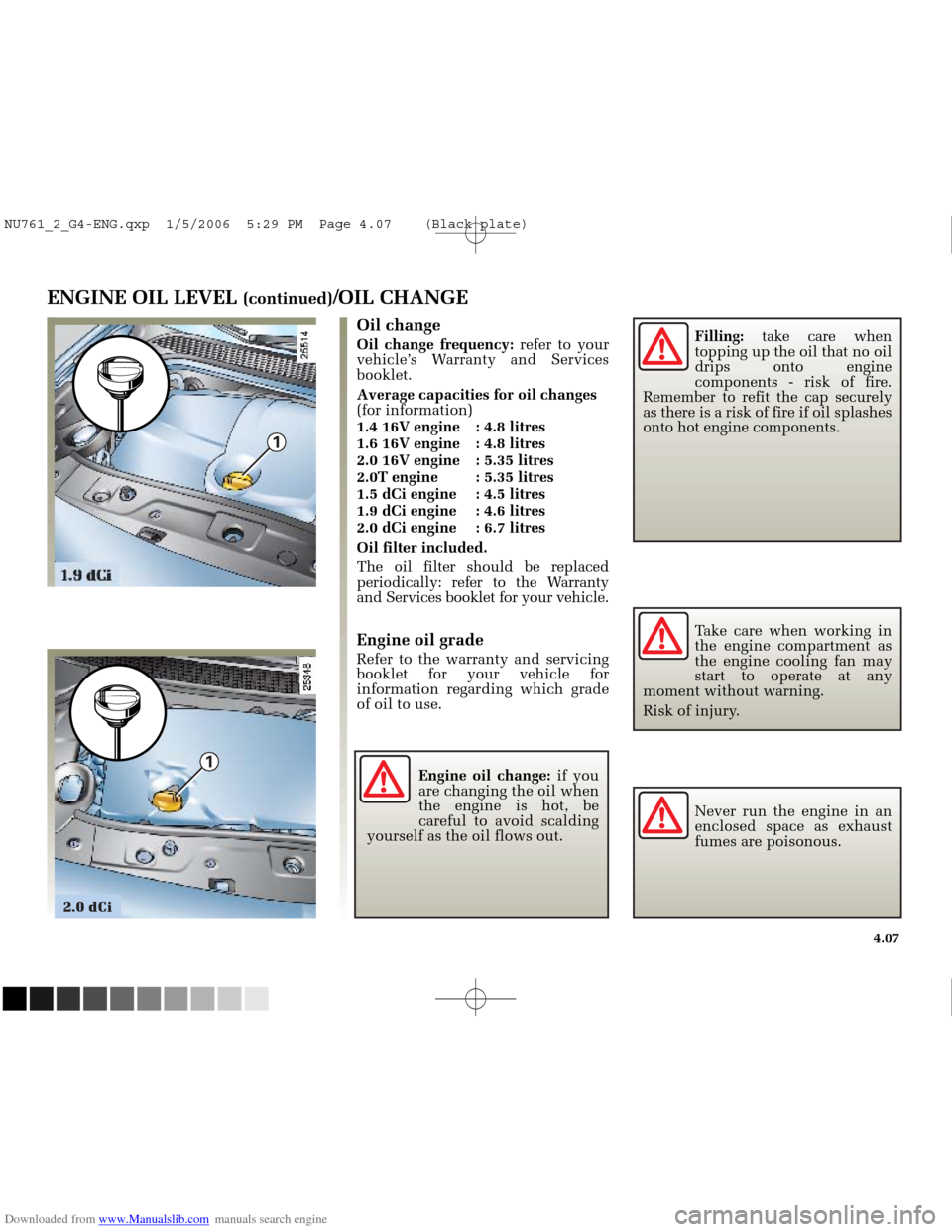
Downloaded from www.Manualslib.com manuals search engine
1
2.0 dCi
1
NU761_2_G4-FRA.qxd 14/11/05 10:11 Page 4.07
4.07
ENGINE OIL LEVEL (continued)/OIL CHANGE
Oil change
Oil change frequency: refer to your
vehicle’s Warranty and Services
booklet.
Average capacities for oil changes
(for information)
1.4 16V engine : 4.8 litres
1.6 16V engine : 4.8 litres
2.0 16V engine : 5.35 litres
2.0T engine : 5.35 litres
1.5 dCi engine : 4.5 litres
1.9 dCi engine : 4.6 litres
2.0 dCi engine : 6.7 litres
Oil filter included.
The oil filter should be replaced
periodically: refer to the Warranty
and Services booklet for your vehicle.
Engine oil grade
Refer to the warranty and servicing
booklet for your vehicle for
information regarding which grade
of oil to use.
Engine oil change: if you
are changing the oil when
the engine is hot, be
careful to avoid scalding
yourself as the oil flows out. Never run the engine in an
enclosed space as exhaust
fumes are poisonous. Take care when working in
the engine compartment as
the engine cooling fan may
start to operate at any
moment without warning.
Risk of injury. Filling:
take care when
topping up the oil that no oil
drips onto engine
components - risk of fire.
Remember to refit the cap securely
as there is a risk of fire if oil splashes
onto hot engine components.
NU761_2_G4-ENG.qxp 1/5/2006 5:29 PM Page 4.07 (Black plate)
Page 182 of 250
Downloaded from www.Manualslib.com manuals search engine
1
NU761_2_G4-FRA.qxd 14/11/05 10:11 Page 4.08
4.08
LEVELS
Frequency for checking coolant level
Check the coolant level regularly
(very severe damage is likely to be
caused to the engine if it runs out of
coolant).
If topping up is required, only use
products approved by RENAULT’s
Technical Department:
- anti-freeze protection;
- anti-corrosion protection of thecooling system. Replacement interval
Refer to the Warranty and Services
booklet for your vehicle.
Coolant level
The level
when cold should be
between the MIN and MAX marks
on the expansion bottle 1.
Top this level up when coldbefore it
reaches the MIN mark.
Consult your RENAULT Dealer at
once if you notice an abnormal or
repeated drop in any of the fluid
levels.
No operations should be
carried out on the cooling
circuit when the engine is
hot.
Danger of burns.
NU761_2_G4-ENG.qxp 1/5/2006 5:29 PM Page 4.08 (Black plate)
Page 183 of 250
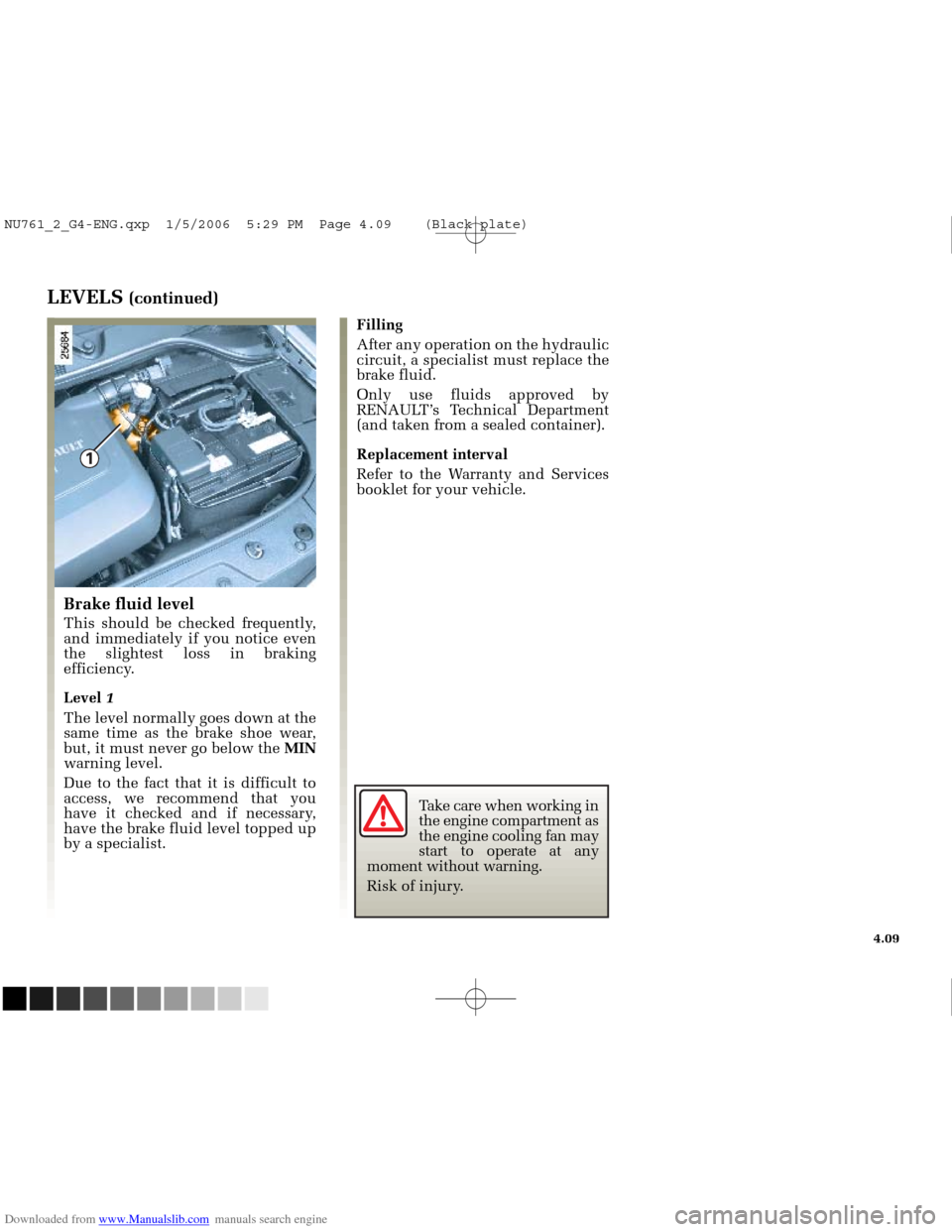
Downloaded from www.Manualslib.com manuals search engine
1
NU761_2_G4-FRA.qxd 14/11/05 10:11 Page 4.09
4.09
LEVELS (continued)
Brake fluid level
This should be checked frequently,
and immediately if you notice even
the slightest loss in braking
efficiency.
Level 1
The level normally goes down at the
same time as the brake shoe wear,
but, it must never go below the MIN
warning level.
Due to the fact that it is difficult to
access, we recommend that you
have it checked and if necessary,
have the brake fluid level topped up
by a specialist. Filling
After any operation on the hydraulic
circuit, a specialist must replace the
brake fluid.
Only use fluids approved by
RENAULT’s Technical Department
(and taken from a sealed container).
Replacement interval
Refer to the Warranty and Services
booklet for your vehicle.
Take care when working in
the engine compartment as
the engine cooling fan may
start to operate at any
moment without warning.
Risk of injury.
NU761_2_G4-ENG.qxp 1/5/2006 5:29 PM Page 4.09 (Black plate)
Page 184 of 250
Downloaded from www.Manualslib.com manuals search engine
1
NU761_2_G4-FRA.qxd 14/11/05 10:11 Page 4.10
4.10
LEVELS (continued)FILTERS
The replacement of filter elements
(air filter, passenger compartment
filter, diesel filter, etc.) is scheduled
in the servicing and maintenance
operations for your vehicle.
Frequency for replacing filter
elements: refer to the Warranty and
Services booklet for your vehicle.
Windscreen/headlight washer
reservoir
Filling
Open cap 1, fill until you see the
liquid, then refit the cap.
Liquid
Screen wash product (product with
anti-freeze in winter). Jets
Use a tool such as a needle to adjust
the height of the windscreen washer
jets.
NOTE
Depending on the vehicle, to find
out the fluid level, open cap 1,
take out the gauge and read the
level.
Take care when working in
the engine compartment as
the engine cooling fan may
start to operate at any
moment without warning.
Risk of injury.
NU761_2_G4-ENG.qxp 1/5/2006 5:29 PM Page 4.10 (Black plate)
Page 187 of 250
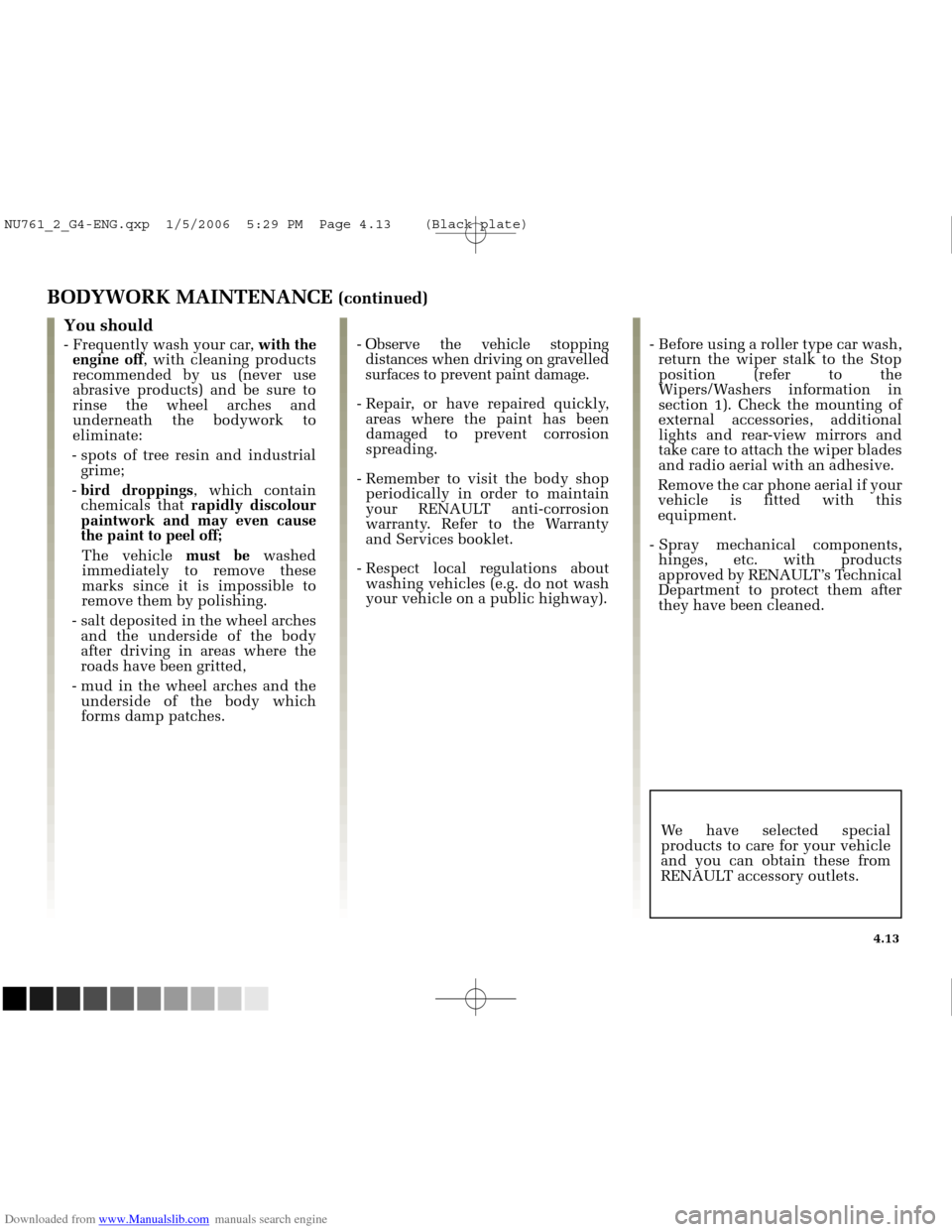
Downloaded from www.Manualslib.com manuals search engine
NU761_2_G4-FRA.qxd 14/11/05 10:11 Page 4.13
4.13
BODYWORK MAINTENANCE (continued)
You should
- Frequently wash your car, with the
engine off , with cleaning products
recommended by us (never use
abrasive products) and be sure to
rinse the wheel arches and
underneath the bodywork to
eliminate:
- spots of tree resin and industrial grime;
- bird droppings , which contain
chemicals that rapidly discolour
paintwork and may even cause
the paint to peel off;
The vehicle must bewashed
immediately to remove these
marks since it is impossible to
remove them by polishing.
- salt deposited in the wheel arches and the underside of the body
after driving in areas where the
roads have been gritted,
- mud in the wheel arches and the underside of the body which
forms damp patches. - Observe the vehicle stopping
distances when driving on gravelled
surfaces to prevent paint damage.
- Repair, or have repaired quickly, areas where the paint has been
damaged to prevent corrosion
spreading.
- Remember to visit the body shop periodically in order to maintain
your RENAULT anti-corrosion
warranty. Refer to the Warranty
and Services booklet.
- Respect local regulations about washing vehicles (e.g. do not wash
your vehicle on a public highway). - Before using a roller type car wash,
return the wiper stalk to the Stop
position (refer to the
Wipers/Washers information in
section 1). Check the mounting of
external accessories, additional
lights and rear-view mirrors and
take care to attach the wiper blades
and radio aerial with an adhesive.
Remove the car phone aerial if your
vehicle is fitted with this
equipment.
- Spray mechanical components, hinges, etc. with products
approved by RENAULT’s Technical
Department to protect them after
they have been cleaned.
We have selected special
products to care for your vehicle
and you can obtain these from
RENAULT accessory outlets.
NU761_2_G4-ENG.qxp 1/5/2006 5:29 PM Page 4.13 (Black plate)
Page 220 of 250
Downloaded from www.Manualslib.com manuals search engine
NU761_2_G5-FRA.qxd 4/11/05 11:10 Page 5.32
OPERATING FAULTS (continued)
When the starter is activated CAUSES REMEDIAL ACTION
There is no response, the indicator lights fail to light up and the starter
does not turn. Battery lead disconnected or terminals
oxidised.
Check battery terminals: scrape and
clean if oxidised and re-tighten.
Discharged battery. Connect another battery to the faulty battery.
Battery unserviceable. Replace battery. Do not push the vehicle if the steering
column is locked.
Warning light bulbs go dim and starter turns very slowly. Battery terminals not tight, battery
terminals oxidised. Check battery terminals: scrape and
clean if oxidised and re-tighten.
Discharged battery. Connect another battery to the faulty battery.
5.32
NU761_2_G5-ENG.qxp 1/5/2006 5:30 PM Page 5.32 (Black plate)